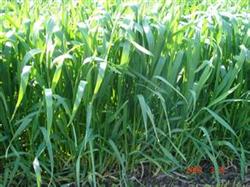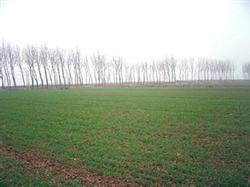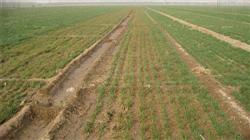There are skills in the control of wheat diseases and insect pests after spring.

The period from re-greening to jointing stage is the peak period of infection and expansion of root diseases such as wheat take-all disease, sheath blight, root rot and virus diseases such as bush dwarf disease and yellow dwarf disease, which is also the peak period of damage. This period is the peak period of wheat spiders, underground pests and weeds, which is a key link of integrated control of wheat diseases and insect pests. To strengthen fitness cultivation and prevent diseases, pests and weeds, we should organically combine cultivation measures with pest control, vigorously promote high-yield fitness cultivation techniques such as hoeing, topdressing and watering in due season, and improve wheat resistance to various diseases. Weeds can be eradicated by hoeing at the right time. At the same time, chemical weeding should be carried out in time after the wheat returns to green from late February to mid-March. In recent years, wheat root diseases, mainly sheath blight, have serious effects on wheat yield, especially on high-yield plots. The key technique of wheat sheath blight control is one mixture and one spray, i. e. seed dressing at sowing stage and spraying at returning green stage. In the control of wheat sharp eyespot, there was spray control which ignored the green stage and the control time was late, which was the main reason for poor control effect. Therefore, we should pay attention to the prevention and control of returning green period, grasp the appropriate period of prevention and control, adopt the right pesticide to carry out prevention and control according to the disease and insect pest control index, vigorously apply the mixed application technology of pesticides and fungicides, and implement scientific prevention and control. The control indexes of diseases and insect pests during the period from re-greening to jointing stage of wheat are: 15%~20% of diseased plants for sheath blight, 3% of damaged wheat seedlings for underground pests, and 600 single wheat spiders per meter. 5% Jinggangmycin can be used to control sheath blight by spraying 75~100 kg water per mu, and spraying again every 10~15 days; 40% isofenphos methyl or 50% phoxim can be used to control underground pests by spraying 40~50 ml per mu; 73% propargit EC can be used to control wheat spiders by spraying 1500~2000 times. The heading stage of wheat is the concentrated occurrence period and peak damage period of wheat aphid, aphid, midge, powdery mildew, stripe rust, leaf rust, leaf blight, scab and glume blight. These perennial diseases and insect pests to wheat aphids occurred in the largest area, the most serious damage. The heading stage of wheat is the final yield stage of wheat, and it is also the peak stage of concentrated occurrence of various diseases and insect pests. Once the diseases and insect pests are damaged, irreparable losses can be caused. Therefore, the heading stage of wheat is the last link of integrated control of wheat diseases, insect pests and weeds, and it is also the most critical period. The wheat field is the winter site and early spring breeding base of many kinds of natural enemies. Protecting the natural enemies of wheat field is not only beneficial to control wheat pests, but also the main source of natural enemies of subsequent crop pests. Chemical control should be based on wheat pest control indicators, seize the appropriate control period, use the right chemicals to carry out control, vigorously apply pesticides and fungicides mixed application technology, implement scientific control. (1) The control indexes of main diseases and insect pests in wheat panicle stage are: 500 wheat aphids per 100 panicles, 25 sticky insects per square meter of the first generation, 5 midges per square (10 cm ×10 cm ×20 cm) in pupa stage, 10~25 midges in adult stage, 2%~5% of diseased leaves for stripe rust, 5%~10% of diseased leaves for leaf rust and 10% of diseased leaves for powdery mildew. (2) The pesticides, dosage and method of application are as follows: 2.5% dichlorothion emulsifiable concentrate or 50 aphid mist wettable powder can be sprayed at 10~ 15ml/mu to control wheat aphid; 50% phoxim emulsifiable concentrate can be sprayed at 50~ 75ml/mu to control the first generation armyworm; 30g 25% Breton wettable powder or 50~ 75ml 40% triadimefon emulsifiable concentrate can be sprayed at 30g/mu to control rust and powdery mildew; 50% carbendazim WP can be sprayed 75~ 100g/mu to control scab, leaf blight and glume blight. (3) Mixed application technology should be applied scientifically according to control objects and control indexes. Single application should be carried out when single pest occurs heavily and others occur lightly, so as to avoid waste and pesticide pollution. 4. Wheat scab and glume blight should be mainly prevented. In case of continuous overcast weather at heading stage, spraying should be used to prevent wheat after flowering. Although wheat midge is a pest in ear stage, its suitable control period is in pupa stage in middle and late April. It should be controlled in pupa stage to improve the control effect. It can be spread on the ground with 150~200 ml of 40% isofenphos methyl EC per mu and hoe 30~40 kg of fine sand or fine sand soil. The better control effect is watering after application. If it cannot be controlled at pupa stage, midge can be controlled at adult stage by spraying 50~ 75ml of 50% phoxim EC at about 70% heading stage of wheat in field.
- Prev

Potassium should be replenished in time for low temperature wheat in spring
In order to cooperate with the spring action of soil testing and formula fertilization, recently, experts from the Chinese Academy of Agricultural Sciences went to Gaocheng, Hebei Province to track the growth of wheat. The survey found that due to the low ground temperature this spring, the turning green of winter wheat in this region was 10 days later than in previous years, and the first Internode of wheat was longer than in previous years, while the second Internode had not grown well.
- Next

Spring Management measures of Winter Wheat in Northern Xinjiang
Return to the green period to manage the spring rake in time after the beginning of spring (from the end of March to early April), with a depth of 5 cm. It is better to use a rake or oblique rake. Returning to green fertilizer should be applied on the eve or early stage of wheat turning green, and should be applied more in weak seedlings, little or no in strong seedlings, and not in prosperous seedlings. Before winter, the total number of stems per mu is less than 400000 seedlings, and the wheat fields with weak wheat seedlings are late.
Related
- The first cup of black tea in spring, the flavor and history of tea gardens in Kenya, Africa
- The computer can not only choose potatoes, but also grow tea rice. AI will grow winter oolong tea champion.
- It is not only the inflated tea bitten by insects, but also engraved with the four seasons tea in Beipu.
- The Oriental Beauty Tea Festival in Zhuxian County takes the stage at the weekend to experience the plus-size feast of oil tea.
- & quot; Oriental Beauty Tea & Exploration of Emei in Hsinchu, the hometown of quot;
- The new variety of strawberry "Tainong 1" dessert is the first choice with mellow aroma. Crimson gorgeous
- History of Tea in Taiwan: from Wild Inner Mountain to Export Tea Garden
- Two types of Taiwan Oriental Beauty Black Tea won the British three-Star Award for Childhood Tea Xiang Zhang Jiaqi changed from pilot to champion tea maker.
- Banana species and varieties: the planting history of Taiwan Xianren banana and dwarf banana is long, is banana disease resistant?
- Coffee planting Technology: Qianjie Coffee from Seedling to harvesting

